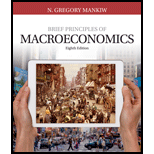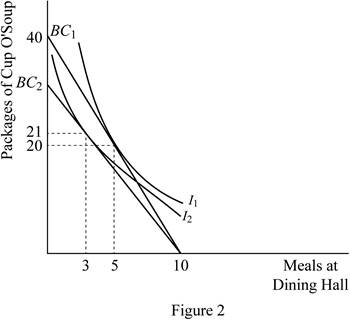
Concept explainers
Subpart (a):
The budget constraint and trade-off.
Subpart (a):
Explanation of Solution
When the wants and needs of a human are unlimited and the budget of an individual is limited, it will lead to a constraint of needs and this constraint raised is due to the limited budget is known as the budget constraint of an individual. Thus, the budget constraint is defined as the possible combination of goods and services that is purchased at a given price level with the entire income.
Here, the income of the person is given as $60, the price of one meal at dining hall is $6, and the price of cup 'o soup is $1.5. Thus, when the consumer spends her entire income on the meal in dining hall, the quantity that she receives can be calculated by dividing the income by the per meal price as follows:
Thus, when she spends all her income on meal from dining hall, she can buy 10 meals. When she spends all her income on the cup 'o soup meal, the quantity can be calculated by replacing the price of dining hall meal with that of cup 'o soup as follows:
Thus, when she spends all her income on the cup 'o soup meals, she can receive 40 cup 'o soup meals.
The budget constraint represents all the combinations of these two goods ranging between 10 dining hall meals and no cup 'o soup meal to no dining hall meals and 40 cup 'o soup meals. However in this case, the consumer spends her income equally on both of the commodities. Thus, she spends $30 each on dining hall meals and cup 'o soup meals. Thus, when the consumer spends $30 on the meal in dining hall, the quantity that she receives can be calculated by dividing the income by per meal price as follows:
Thus, when she spends $30 of her income on meal from dining hall, she can buy 5 meals. When she spends $30 of her income on the cup 'o soup meal, the quantity can be calculated by replacing the price of dining hall meal with that of cup 'o soup as follows:
Thus, when she spends $30 of her income on the cup 'o soup meals, she can receive 20 cup 'o soup meals. This will be the point of her consumption, when the income is equally spent on both commodities. The graphical representation shows this combination at point A and it is represented as follows:

Concept introduction:
Budget constraint: Budget constraint is defined as the possible combination of goods and services that is purchased at a given price level with the entire income.
Normal good: The goods whose quantity demanded increases, when the income of the consumer increases and vice versa.
Inferior good: The goods whose quantity demanded falls, when the income of the consumer increases and vice versa.
Giffen goods: They are the special cases of inferior goods in which an income effect overweighs the substitution effect.
Subpart (b):
The budget constraint and trade-off.
Subpart (b):
Explanation of Solution
When the price of the cup o' soup increases to $2 from $1.5, the vertical intercept of the student's budget constraint will shift downwards; this will flatten the budget constraint curve. When she spends all her income on the cup 'o soup meal, the quantity can be calculated by replacing the price of dining hall meal with that of cup 'o soup as follows:
Thus, when she spends all her income on the cup 'o soup meals, she can only receive 30 cup 'o soup meals. This flattens the budget constraint curve.
It is also said that at present she only spends 30 percent of her income on the dining hall meal, which means that the income spent on dining hall meal is only $18 and that spend on cup o' soup is $42. At this income spending distribution, she can purchase 3 units of dining hall meals and 21 units of cup o' soup meals. This new point can be illustrated as point B and it can be represented as follows:

Concept introduction:
Budget constraint: Budget constraint is defined as the possible combination of goods and services that is purchased at a given price level with the entire income.
Normal good: The goods whose quantity demanded increases, when the income of the consumer increases and vice versa.
Inferior good: The goods whose quantity demanded falls, when the income of the consumer increases and vice versa.
Giffen goods: They are the special cases of inferior goods in which an income effect overweighs the substitution effect.
Subpart (c):
The budget constraint and trade-off.
Subpart (c):
Explanation of Solution
The initial price of cup o' soup was $1.5, and the new price after the increase is $2. The initial quantity demanded of cup o' soup was 20 units; whereas after the increased price of the commodity, the quantity demanded is 21 units. This shows that the demand for the commodity will increase, when the price of the commodity increases. This shows that the cup o' soup is an inferior good for which the income effect overweighs the substitution effect.
Concept introduction:
Budget constraint: Budget constraint is defined as the possible combination of goods and services that is purchased at a given price level with the entire income.
Normal good: The goods whose quantity demanded increases, when the income of the consumer increases and vice versa.
Inferior good: The goods whose quantity demanded falls, when the income of the consumer increases and vice versa.
Giffen goods: They are the special cases of inferior goods in which an income effect overweighs the substitution effect.
Subpart (d):
The budget constraint and trade-off.
Subpart (d):
Explanation of Solution
The initial price of cup o' soup was $1.5, and the new price after the increase is $2. The initial quantity demanded of cup o' soup was 20 units denoted by point A; whereas after the increased price of the commodity, the quantity demanded is 21 units denoted by point B. This shows that the demand for the commodity will increase, when the price of the commodity increases. Thus, these two points can be graphically illustrated as follows:

Here, the demand for the cup o' soup increases, when its price increases, which means that the commodity is an inferior good. However at the same time, the income effect overweighs the substitution effect for the commodity, which is a special case of inferior goods, known as the Giffen goods. Thus, the cup o' soup is a Giffen good.
Concept introduction:
Budget constraint: Budget constraint is defined as the possible combination of goods and services that is purchased at a given price level with the entire income.
Normal good: The goods whose quantity demanded increases, when the income of the consumer increases and vice versa.
Inferior good: The goods whose quantity demanded falls, when the income of the consumer increases and vice versa.
Giffen goods: They are the special cases of inferior goods in which an income effect overweighs the substitution effect.
Want to see more full solutions like this?
Chapter 21 Solutions
Bundle: Principles Of Economics, Loose-leaf Version, 8th + Lms Integrated Mindtap Economics, 1 Term (6 Months) Printed Access Card

 Principles of Economics (MindTap Course List)EconomicsISBN:9781305585126Author:N. Gregory MankiwPublisher:Cengage Learning
Principles of Economics (MindTap Course List)EconomicsISBN:9781305585126Author:N. Gregory MankiwPublisher:Cengage Learning

 Economics (MindTap Course List)EconomicsISBN:9781337617383Author:Roger A. ArnoldPublisher:Cengage Learning
Economics (MindTap Course List)EconomicsISBN:9781337617383Author:Roger A. ArnoldPublisher:Cengage Learning





